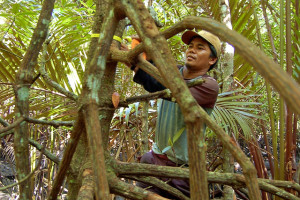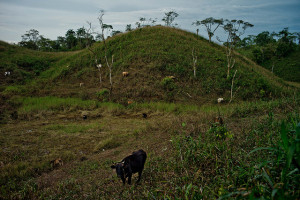Originally published at CIFOR’s Forests News

Research on climate change makes up a big part of the CGIAR Research Program on Forests, Trees and Agroforestry. On the occasion of the SBSTA in Bonn, Stephen Lawry, Director Forests & Governance Research at the Center for International Forestry Research (CIFOR), explains how seven Asian countries’ should not overlook how private sector contributions could help their plans to finance climate mitigation through land use. The 44th meeting of the UNFCCC Subsidiary Body for Scientific and Technological Advice (SBSTA) takes place in Bonn, Germany, from 16-26 May 2016.
The Paris Agreement was built on countries’ Intended Nationally Determined Contributions (INDCs) – national roadmaps towards limiting global warming to 1.5°C. In Asia, preventing emissions from land use change is the clearest path to delivering on national commitments.
Major private sector actors, in response to pressure from consumers and civil society, are taking the lead in the region. Dozens of companies are making efforts to meet zero deforestation and sustainable palm oil targets. And many banks are reassessing the risks associated with investments that don’t meet certain social and environmental standards.
Seems like the perfect solution for countries faced with the challenge of meeting climate mitigation targets on limited finances.
But a new report that looked at the INDCs of seven countries in Asia found that most neglected to acknowledge the potential of the private sector to contribute to national climate targets related to mitigation through land use.
HIGH POTENTIAL

Agriculture, forestry and other land use (AFOLU) represents 20–24% of global greenhouse gas (GHG) emissions. The Paris Agreement formally recognizes the role of the AFOLU sector in climate change mitigation and states that all Parties should take action to conserve and enhance GHG sinks and reservoirs.
Because the region accounts for largest proportion of global AFOLU emissions, Asia has the highest potential for both technical and economic mitigation by harnessing cost-effective emission reductions in the AFOLU sector.
If you consider all technically feasible ways to reduce these emissions, across all GHG gases, between 550 and 1,300 million tons of CO2 equivalent could be saved each year by 2030. The Asian region provides almost all of the global mitigation potential for rice cultivation, including the largest potential for restoration of organic soils (due to cultivated Southeast Asian peats).
Therefore, in Asia, if you’re not focusing climate mitigation efforts on AFOLU, you’re not addressing climate change. And if you’re not focusing on the role of private sector, you’re overlooking what may be the single most important source finance and capacity to meet national mitigation and adaptation targets.
HIGH COST
Between now and 2030, INDCs will evolve into Nationally Determined Contributions, which will need to be updated – and improved – every five years. This process gives countries the opportunity to detail their need for financing and to gain access to continuously evolving global climate finance.
Given the scale of investment required and the diversity of financial services and products needed (long-term investments, small scale credit, insurance, etc.), it’s clear that both private and public finance will be needed.
More and more, private lenders are requiring borrowers to subscribe to higher environmental, social and governance standards as conditions for receiving loan finance. So, private finance can be a critical source of capital for funding agricultural projects that support the achievement of national climate goals.
Yet most countries fail to make that link in their INDCs.
MISSING THE MARK
The study analyzed how low emission development strategies (LEDS) for AFOLU are included in INDCs and national development plans and strategies in Bangladesh, Cambodia, India, Indonesia, Lao PDR, Thailand and Vietnam. The countries were selected because they represent a variety of AFOLU emission profiles and development priorities.
My contribution to the report focused on analyzing how the INDCs propose to finance implementation of national climate mitigation and adaptation goals, particularly in the AFOLU sector.
Most INDCs cite the need for international support in the form of finance, technology and capacity building. Some countries provide estimated costs and the level of support required.
But none make note of the potential contributions from private companies that have made commitments in recent years to reduce emissions associated with large-scale production, trade and manufacturing of timber and agricultural commodities. Where the role of the private sector is mentioned in INDCs, no concrete measures to leverage its potential are given.
Significantly, the INDCs do not consider the growing trend of financial service providers to finance AFOLU investments that mitigate GHG emissions – potentially at very large scale.
To date, major global banks have been leaders in environment, social, governance (ESG) lending. But until recently companies that were unwilling to take up ESG standards could simply turn to domestic banks for loans, often at competitive rates.
Lately, however, Singapore and Indonesian financial sector regulators have started ensuring that their national commercial banks apply ESG lending standards to projects they finance, with a particular focus on the AFOLU sector. And, as an incentive, HSBC now offers discounted finance for RSPO-certified palm oil.
If successfully implemented, these measures could significantly reduce GHG emissions from the land use sector.
In summary, our study shows there is a limited understanding of private sector leadership in this area. Private sector finance and private companies’ commitments to produce commodities sustainably can contribute significantly to national commitments. Acknowledging the ways in which markets are driving changes in company behavior is a first step toward bridging the gap between national and private sector commitments.











